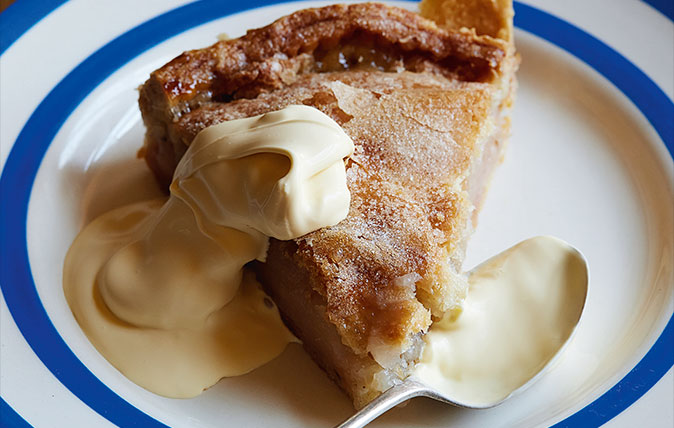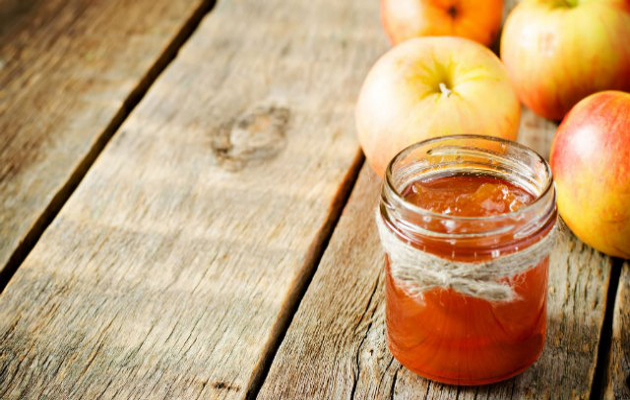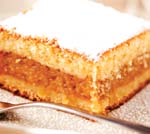The ultimate apple pie recipe
There's nothing quite like a perfect apple pie – Simon Hopkinson shares his recipe to help you get it just right.


The particular pie I cooked for the photograph that illustrates this recipe used Rose’s apples. Their flavour and texture reminded me of the fruit from a few trees in the garden in which I grew up, in Lancashire: sweet-sour, a touch blown, collapsed and pink-tinged (rhubarb springs to mind) once cooked, but with a true apple fragrance to the fore.
As an alternative, a well-ripened Cox or Russet would be suitable. And, although Bramleys dutifully collapse well in a baked pie, their flavour will, how shall we say, always be a little one-dimensional.
One very important last note: please adhere to the instruction of only using egg white (rather than the usual egg-wash using a whole, beaten egg) with which to both seal the pastry edges together and, more importantly, to glaze the surface of the pie before baking. This is a relatively recent move for me and was inspired by the superlative crust always achieved when following the traditional recipe for the fashioning of an Eccles cake.
With this, it is only ever beaten egg white that’s traditionally used and, with a generous sprinkling of caster sugar (only fine white, please!) to finish, the pie will emerge as shining and crusted as never before. Use a loose-bottomed tart tin measuring about 20cm wide by 4cm deep (8in by 1½in).
Simon Hopkinson's ultimate apple pie
Ingredients
- 800g–900g Cox’s, Rose's or Russet apples, peeled and sliced into small pieces
- The juice of a small lemon
- 5 cloves
- 175g caster sugar
- 1 scant tbspn cornflour
- 15g softened butter
- 500g puff pastry
- 1 egg white, loosely beaten with a fork

Method
Pre-heat the oven to 180˚C/350˚F/gas mark 4, together with a flat baking sheet. Mix the apples with the cloves, lemon juice, 150g of the sugar and the cornflour. Set aside. Lightly grease the tin. Roll out two-thirds of the pastry to line the tin (don’t make it too thin), allowing for a slight excess to flop over the rim.
Tip in the apples (which might look too many, but, be assured, they will flop down as they cook), dot with the butter and lightly press them down with your hands.
Brush a little egg white around the edge of the pastry, roll out the remaining one-third of pastry, but to a slightly thinner degree than the base. Carefully drape it over the apples and, with your fingers, firmly press the two pastry edges together.
Exquisite houses, the beauty of Nature, and how to get the most from your life, straight to your inbox.
Now, using a sharp knife, cut through the joined edges almost flush up to the rim, knock up the pastry join to form a crinkled edge all the way around and decorate with the tines of a fork.
Generously brush the surface with egg white and evenly sprinkle with the remaining 25g of caster sugar. Make 3–4 incisions in the centre of the pastry lid with a small knife, so that steam may escape. Place the pie on the baking sheet and cook for 20 minutes.
Then, reduce the temperature to 150˚C/300˚F/gas mark 2 and continue to cook for a further 35–40 minutes or until the pie-crust is well stippled with sugar crystals and there is also clear evidence of burbling, golden apple juices erupting from within the pie, both through the central vents and around the edges. Mind you, it’s the intoxicating smell, above all, that tells you the thing is ready. Leave to cool for 10 minutes, before un-moulding.

Apple recipe guide: Cake, crumble, chutney and more
Make apple cake, crumble and chutney with the windfall you're accumulating

Perfect apple recipes: Pork, apple & sage burger with caramelised onions
This lovely recipe for pork and apple burgers is simple, and hits the spot.

Greatest Recipes Ever: Apple Dessert Cake
Thomasina Miers recommends Mary Berry’s apple dessert cake as one of her greatest recipes ever.

Five favourite crumble recipes for winter
Read our top crumble recipes, from rhubarb and ginger to toffee apple crumble
